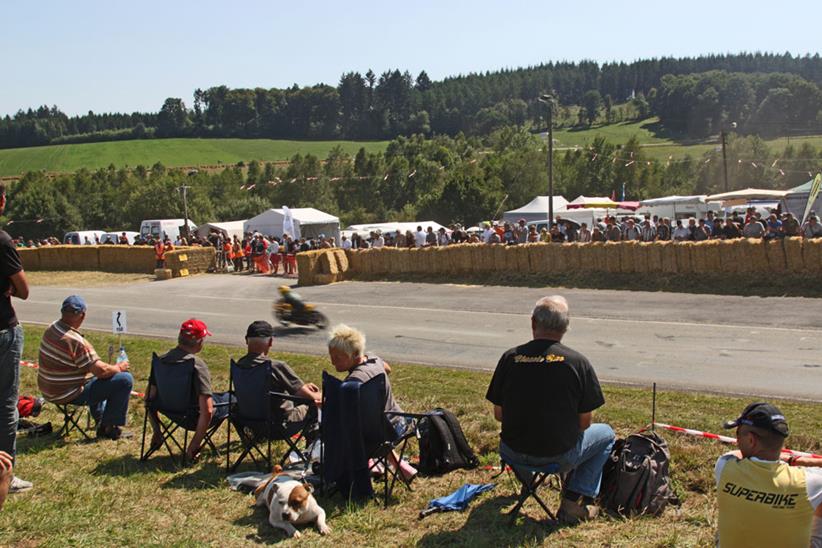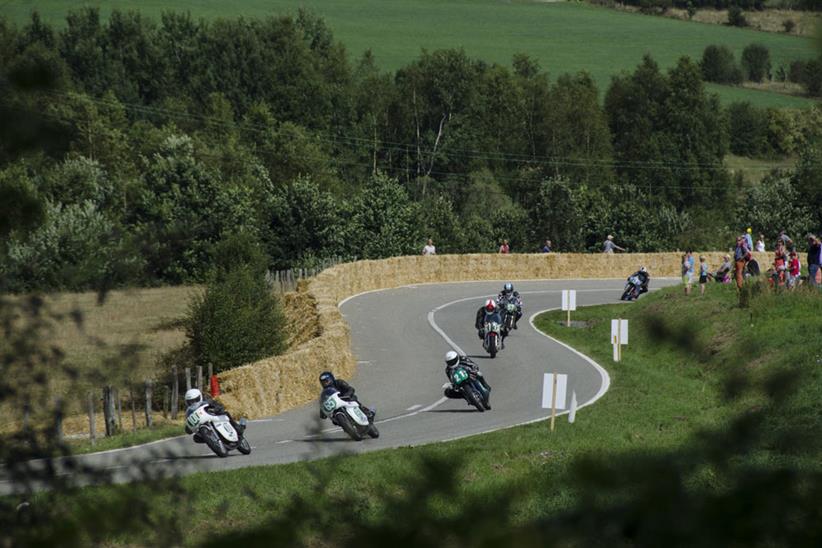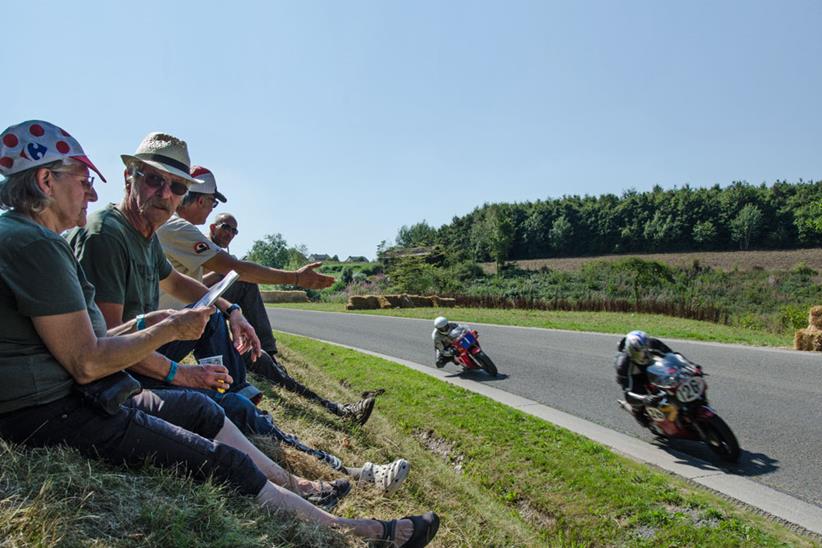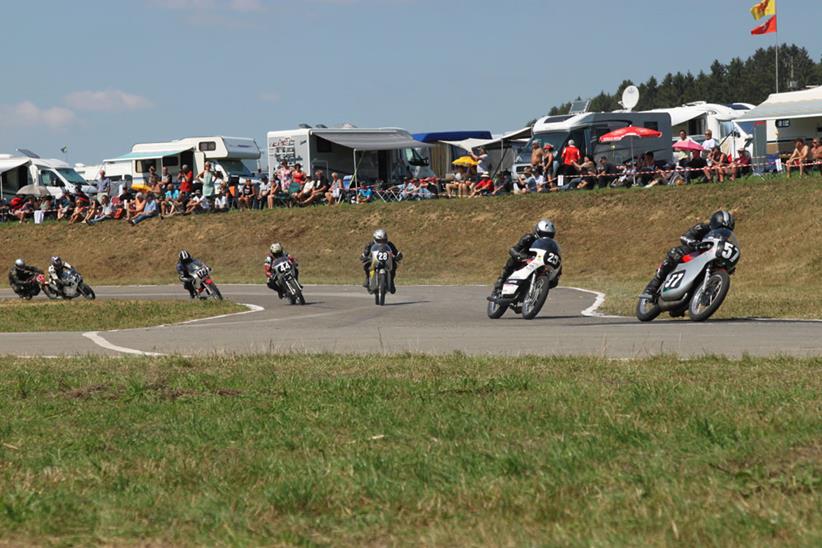The best race weekend you’ve never heard of
Four hours from Calais is a jewel of a road circuit with three beer stations, and a mouth-watering range of old bikes
![]() e’re up in the woods, high above the start line. It’s so quiet you can hear a fly buzzing among the leaves. Huge straw bales tied to the trees hint at something momentous. And then, a mile away, the flag drops. We know because of the sudden rumble, followed by near silence as the sidecar swarm shuts off for turn one.
e’re up in the woods, high above the start line. It’s so quiet you can hear a fly buzzing among the leaves. Huge straw bales tied to the trees hint at something momentous. And then, a mile away, the flag drops. We know because of the sudden rumble, followed by near silence as the sidecar swarm shuts off for turn one.
Bit by bit, the approach begins. At first it’s just a generalised (if slightly unsettling) grumbling roar as the pack moves up the valley like an advancing medieval army. But soon, individual bikes rise above the din, the blats and cracks of their exhaust notes merging, throbbing and separating again. Still we can’t see anything. We just know that something big and scary is approaching.
It’s like waiting for an attack. Which in a way is what you get: an attack on your ears, eyes, and guts as these archaic contraptions burst into view, each one a blur of sprouting cylinders, leather-clad limbs, fabricated aluminium and trailing oil vapour. Dust billows up into a shaft of sunlight as the leaders’ inside wheels scud across the grass 100 yards away.
![]() They flash past, almost in touching distance, every passenger contorted into a different position by his (or, more usually, her) physical build and the vagaries of the passenger platform. The commonest technique is head an inch from the road, right leg stretched over left. Others spread-eagle face down for max aero; twist out from a kneeling position; or hook a knee, frog-style, over the wheel arch. One of the bikes, a big Brit twin, coughs, gives a massive pop, and coasts to a halt as it expires.
They flash past, almost in touching distance, every passenger contorted into a different position by his (or, more usually, her) physical build and the vagaries of the passenger platform. The commonest technique is head an inch from the road, right leg stretched over left. Others spread-eagle face down for max aero; twist out from a kneeling position; or hook a knee, frog-style, over the wheel arch. One of the bikes, a big Brit twin, coughs, gives a massive pop, and coasts to a halt as it expires.
That was just the warm up lap.
Welcome to the Belgian Classic Trophy at Gedinne – a once-yearly festival of old racebikes held on the triangular ribbon of tarmac connecting three villages deep in cattle country.
Gedinne is the antidote to MotoGP. It has no sponsors to speak of, no VIP lounges whatsoever, and absolutely no run-off. It probably makes about four quid profit, and quite obviously only exists for the love of riding bikes. Fifty years ago all Grands Prix were held in something like the same spirit, on tracks like this, in many cases on similar bikes. The big difference today: less stress. No one is being paid to win a world championship here.
![]() I rode over to Gedinne at the end of August with my wife and three mates. We camped a mile from the circuit, and spent two days wandering around the track, eating chips and gawping at the most extraordinary range of bikes you can see at a classic race: from 50cc GP bikes up to 500cc, backwards to 1940s clonkers, and forwards to drool-tastic bevel Ducatis up against Weslake twins, sledgehammer G50s and Harris and Moto Martin specials. It’s a brilliant way to spend a long weekend.
I rode over to Gedinne at the end of August with my wife and three mates. We camped a mile from the circuit, and spent two days wandering around the track, eating chips and gawping at the most extraordinary range of bikes you can see at a classic race: from 50cc GP bikes up to 500cc, backwards to 1940s clonkers, and forwards to drool-tastic bevel Ducatis up against Weslake twins, sledgehammer G50s and Harris and Moto Martin specials. It’s a brilliant way to spend a long weekend.
Besides the paddock, which combines the delights of fast food and open-air urinals with the freedom to wander where you like, the more remote bits of the circuit boast two makeshift pubs, and a third kiosk selling soft drinks.
The subtle inference is that you can either use the racing as a background haze to get drunk to, or you can follow every detail and make notes in your programme (printed in black and white, price €1).
Either way, the event is so intimate and friendly that you can’t help becoming part of it. You’re allowed, for example, to walk into the holding bay where riders wait to be called onto the grid. Immediately you notice that the solo riders are totally focused, perhaps contemplating the dire consequences of getting it wrong. The sidecar lot on the other hand, presumably on the basis that a problem shared is a problem halved, are far more companionable. They pass their pre-race minutes, stripped to the waist in the hot sun, helmets off, laughing and joking with their many friends. Some of the female passengers are very pretty, which might be a reason why people get into racing sidecars. A few of the all-male pairings are so huge you wonder how these ancient old motors drag them around. The all-female crew of Anja Braas and Diana Bouman surely have an advantage here.
![]() You can talk to anyone; nobody minds. Dennis and Christine Etheridge are on a Norton kneeler after their preferred weapon (powered by a 1950 Gilera Saturno 500 single) went wrong.
You can talk to anyone; nobody minds. Dennis and Christine Etheridge are on a Norton kneeler after their preferred weapon (powered by a 1950 Gilera Saturno 500 single) went wrong.
“I’m the Queen’s pearl-stringer, you know,” says Christine in her irresistibly charming south-east accent. “We’ve always been a racing family, and when the children were grown up my husband said, ‘I’m going to look for a sidecar passenger.’ ‘No you’re not,’ I said. ‘I’m getting in there. I’m fed up with clearing up after everyone.’ I was 43. I’m 70 now. I still do a bit of cooking but I don’t have to clear up afterwards. And I’ve finally found a young person I can teach the pearl work to. Otherwise the skill will be lost.”
A few feet away is a tough-looking, bullet-headed guy, hairy back, leathers round his waist. He’s sitting in his sidecar because it’s the only place to sit. He’s got a set of carbs in one hand, and a box of jets in the other. He’s even holding a couple in his teeth. And he’s out in ten minutes.
But it’s the solos that offer the real spectacle of speed. In the TZ350 class, UK riders Luke Notton, George Hogton Rusling and Dean Stimpson are blisteringly quick. They easily smoke the equivalent-age litre sportsbikes, which for all their power can’t match the corner speed of the little Yamahas.
George is also out on his 750 Carthago Trident, which wafts past everything else like it’s standing still.
“Look, look, look! There!” enthuses the tri-lingual commentator in his superb Flemish accent. “Three seconds in the lead already – Hogton Rusling George! No discussion from this young rider from England.”
Whilst the top guys are international standard quick, some backmarkers look like the slow group on a track day. “I could beat him,” says my wife Fiona as a purple 250 Suzuki bogs down out of a corner. Then again, she’s got an MT-07.
![]() But there’s madder stuff than Brit triples here. Two guys are running König 500s – the outboard-engined GP bikes first developed by Kim Newcombe in 1969. Look at a König and you see an overcomplicated, unreliable mess (it’s a flat-four two-stroke boat engine fitted longways in the frame). Listen to one searing out of a slow corner in pursuit of a £70,000 Paton and it immediately becomes your favourite bike noise of all time. Two-strokes are supposed to sound like ripping calico. Nothing sounds more like that than a König. One of the riders, Clive Ling, said his was making 75bhp.
But there’s madder stuff than Brit triples here. Two guys are running König 500s – the outboard-engined GP bikes first developed by Kim Newcombe in 1969. Look at a König and you see an overcomplicated, unreliable mess (it’s a flat-four two-stroke boat engine fitted longways in the frame). Listen to one searing out of a slow corner in pursuit of a £70,000 Paton and it immediately becomes your favourite bike noise of all time. Two-strokes are supposed to sound like ripping calico. Nothing sounds more like that than a König. One of the riders, Clive Ling, said his was making 75bhp.
Sadly Gedinne recreates the dark side of the 1960s as well. Two riders, Patrick Messerli and Hans van Bregt, were killed this year. Sidecar driver Messerli died (and his passenger Catherine Monti was badly hurt) after a mystery practice crash. The paddock rumour suggested his front tyre came off, but the investigation doesn’t mention it. Van Bregt was only riding a 50cc Minarelli, and again crashed for reasons which are unclear.
It might seem strange, but even after these disasters people found the will to continue. Most racers, after all, have met tragedy before. Late on Saturday we notice two Kiwi ladies walking slowly along the side of the track, staring intently at the grass in the manner of someone who has dropped a washer.
“What are you doing?”
“Looking for an exhaust muffler. It fell off somewhere round here.”
By the next morning the gloom has lifted. Up at turn 10 a guy on a Norton sidecar brakes furiously for the 300-degree right, slithers round and accidentally drags the high compression twin down below stall speed. Finding himself coasting slowly downhill, he stands on the pegs, sits down sharply and bump-starts his outfit back into the race. The crowd applauds. That’s the spirit of Gedinne.
If you fancy the trip out next year, you should do it. Even 400 miles of heavy rain on the way home hasn’t stopped us planning a repeat trip in 2016. “I love the laid-back approach,” said Fiona, who is perfectly capable of being bored to distraction by the intensity and techno-overkill of modern bike racing. “It’s not crowded, everyone is really friendly, the marshalling is very good and the scenery is beautiful. The bikes are really interesting too.”
There’s more about Gedinne (but not much) here
Words Rupert Paul Pictures Rupert Paul, John Westlake










